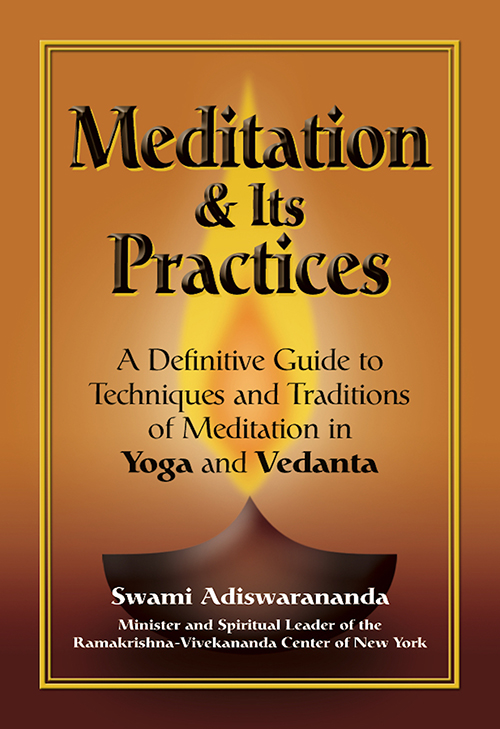
Meditation & Its Practices
Swami Adiswarananda. A Definitive Guide to Techniques and Traditions of Meditation in Yoga and Vedanta.
Hardcover: $24.99
From the Inside Flap
Discover the wisdom of two great teachings of Hindu meditation - in one comprehensive volume.
Yoga and Vedanta ask us to face the problems of life through Knowledge of Reality. The ills of life are not created by God, or by the stars, or by luck, but by our own inability to live in the light of Reality. Good and evil move together; one cannot be separated from the other. There is no absolute definition of good or evil. What is good for one person may be bad for another. The world we live in is in our own mind.— from the Introduction
Meditation is a subject of universal interest, practiced by spiritual explorers of all traditions on the quest for serenity, peace, and wholeness. Among the many traditions of meditation in Hinduism, Yoga and Vedanta have passed the test of time, proving as vital today as they were throughout the ages in helping us overcome the maladies of life and attain the greatest spiritual fulfillment.
In this inspiring guidebook, Swami Adiswarananda, a senior monk of the Ramakrishna Order of India and Spiritual Leader of the Ramakrishna-Vivekananda Center in New York City, outlines the subject of meditation and its practices following the methods and teachings of these two traditions. Defining key concepts in clear terms, Swami Adiswarananda covers every aspect of this ancient spiritual practice, including:
Goals and Benefits of Meditation
Objects of Meditation
Methods of Concentration
Posture, Physical Condition, Eating Habits, and Spiritual Exercises
Mystical Experiences and Realization
Obstacles in Meditation and Ways of Overcoming Them
From the Backside Flap
Swami Adiswarananda, a senior monk of the Ramakrishna Order of India, is the Minister and Spiritual Leader of the Ramakrishna-Vivekananda Center of New York, one of the several centers of the Order in the United States.
"Presents meditation as a universal form of worship - the key to our true well-being and our highest fulfillment. Swami Adiswarananda's personal qualities of vigor, authority, and conviction will inspire readers to pursue the spiritual adventure of meditation with determination and joy." — Kendra Crossen Burroughs, annotator, Bhagavad Gita: Annotated & Explained and Selection from the Gospel of Sri Ramakrishna: Annotated & Explained
The complete sourcebook for exploring Hinduism's two most time-honored traditions of meditation.
The methods of meditation in Yoga and Vedanta do not cater to emotionalism or any form of sentimentalism. They are precise, scientific, and psychological. They do not measure success in meditation by the seeker's dreams or visions, which are personal and private, but by transformation of his or her character. Following these methods of meditation, many have attained direct perception of truth and the fulfillment of life.
From the Back Cover
From the Preface
Meditation is a necessity for the soul, a technique for withdrawing the mind so that the spirit can rest and rejuvenate. By practicing meditation, we set in motion a process that leads to the restoration of our well-being - physical, mental, and spiritual.
This comprehensive sourcebook examines the scientific, psychological, and spiritual properties of Yoga and Vedanta, Hinduism's two mainstream meditation practices, and explains how we can put these teachings into practice to enrich our daily lives. Drawing on the sacred texts of yoga and Vedanta -including the Bhagavad Gita, the Upanishads, and the Gospel of Sri Ramakrishna, among many others - this guidebook illuminates the principles of each of these traditions, the meaning of meditation, and the methods by which we can develop our concentration and self-control.
By exploring the transformative powers of this ancient spiritual practice, the inspiring volume show us time-tested ways to refresh our souls and empower our physical and spiritual selves with innovative ways of meeting the challenges of modern life.
"Fills a long-standing gap in the contemporary literature on meditation. It is a most helpful exposition of the Vedantic perspective on the inward-turning consciousness, which covers all the important and theoretical aspects of the meditative path."— Georg Feuerstein, Ph.D., president, Yoga Research and Education Center
"This book is one of the finest works on meditation I've ever encountered. Deeply embedded in the Hindu tradition, it is thorough, eminently practical, inspiring, and effective. I highly recommend it."— Brother Wayne Teasdale, author, Bede Griffiths: An Introduction to His Interspiritual Thought and A Monk in the World
Preface
Meditation is a subject of universal interest. It is practiced by spiritual seekers of all traditions, in some form or other, for serenity, peace, and blessedness. The time-honored teachings of meditation, as embodied in the systems of Yoga and Vedanta, serve as a source of inspiration to seekers all over the world. Among the many traditions of meditation in Hinduism, the traditions of Yoga and Vedanta are generally regarded as the two mainstream teachings. While both Yoga and Vedanta strive for the same goal, the two systems differ in their approach to that goal. The present book is a study of the subject of meditation and its practices following the methods and teachings of these two systems.
The universal principles of Yoga and Vedanta are four: divinity of the individual soul, unity of existence, oneness of the Ultimate Reality, and harmony of religions. Divinity of the soul is the unshakable spiritual basis of freedom and self-fulfillment. The unity of existence is the foundation of all ethical virtues. Self-love is the mainspring of a man's action and the raison d'être of his love for others. But Yoga and Vedanta remind us that the true self of a person is the self of all beings. While the Ultimate Reality is one, the names, forms, and symbols describing It are various. They are frail attempts of the human mind to name the nameless and attribute form to that which is formless. Oneness of the Ultimate Reality teaches us to remain loyal to our own ideal, but to show positive respect to the ideals of others. All religions are fundamentally the same. Unity in diversity is the law of life and so it is in matters of religion. Different seekers following different paths are all trying to reach the same goal. The methods of meditation in Yoga and Vedanta do not cater to emotionalism or any form of sentimentalism. They are precise, scientific, and psychological. They do not measure success in meditation by the seeker's dreams or visions, which are personal and private, but by transformation of his character. Following these methods of meditation, many have attained to direct perception of truth and the fulfillment of life. These traditions, methods, and teachings of Yoga and Vedanta have passed the test of time and they are as living today as they were in the past.
In support of the presentations in the book, extensive citations have been made from orthodox texts. These texts are The Yoga Aphorisms of Patanjali, The Upanishads, The Bhagavad Gita, Uddhava Gita (The Last Message of Sri Krishna), Vivekachudamani (The Crest Jewel of Discrimination), Aparoksanubhuti (Direct Experience of Reality), The Gospel of Sri Ramakrishna, Sri Ramakrishna, the Great Master, Vivekananda: The Yogas and Other Works, The Teachings of Holy Mother, Sri Sarada Devi, The Laws of Manu, and others. Teachings on the subject of meditation that remain scattered over many texts have been brought together in this volume for the convenience of the spiritual seekers. The explanations given with the texts are based on the orthodox interpretations of Yoga and Vedanta.
The book is the result of painstaking research of several years. Many have worked hard to make this publication possible. I am deeply grateful to Martin Sulzberg, Barry Zelikovsky, Rob Baker, Kendra Crossen Burroughs, Priscilla Carden, Lisa Meyer, Mary Jo Krey, and others for reading and editing the manuscript and giving valuable suggestions. I will feel greatly rewarded if the book is of help to the spiritual seekers in the practice of meditation.
Swami Adiswarananda
Ramakrishna-Vivekananda Center of New York
New York City
Sri Ramakrishna's Birthday
March 5, 2003
Exerpt from the Introducation
Swami Adiswarananda
Life in this world is not what it appears to be. It is plagued by pairs of opposites, such as pain and pleasure, birth and death, and hope and disappointment. It is subject to six changes: birth, subsistence, growth, maturity, decline, and death. Dangers and difficulties pursue us everywhere. Uncertainties at every step of life create anxiety, fear, and hopelessness. Our optimism turns into pessimism, as we grow older. Youthful dreams of happiness and fulfillment rarely come to be true. It is said that a human individual is born crying, lives complaining, and dies disappointed. Asked by a king about the meaning of life, a sage once replied, "A man is born, he suffers, and he dies." More than twenty-five hundred years ago Buddha said that if all the tears that had flowed from human eyes since the beginning of creation were gathered together, they would exceed the waters of the ocean.
Responses to the problem of suffering have been various. Believers in a millennium live with the hope that some day a prophet or an incarnation of God will be born and usher in a golden age of peace and happiness. There are others who try to cope with the problems of life. Dangers and difficulties, uncertainties and changes, they say, are inevitable and nothing can be done about them, and so we must learn to live with them. Transcendentalists try to withdraw from life and seek solace and serenity on the spiritual plane. So-called pragmatists maintain that this life is the only life we have and so we must enjoy it to the full. A bird in the hand is worth two in the bush. Progressivists believe that through the advancement of science and technology some day all evils and ills will be eliminated and then there would be only good. Hardened materialists choose to fight the ills of life solely by material means. People of faith consider life inherently corrupt and sinful, and are of the opinion that any attempt to improve it is futile. They bear with life and practice virtues, hoping for compensation hereafter. But none of the above solutions really helps us to face and overcome the problems of life.
The hopes of the believers in a golden age end in disappointment. The golden age never comes. Coping with the problems of life is easier said than done. There is a limit to coping and beyond that limit life becomes unbearable. The transcendentalists want to escape the problems of life by withdrawing into silence and solitude. But we must not forget that the world follows us wherever we go. The so-called pragmatists also become disappointed because enjoyments only temporarily excite the senses and such excitement is followed by sorrow. Progressivists believe in progress toward good and hope to eliminate evil altogether. But as we make progress toward good, evil also increases in the same proportion; we cannot increase the one without increasing the other. The efforts of the materialists to overcome the problems of life through material means are never successful. All the ills of life are not physical. Material solutions are useless against old age, fear, anxiety, and death. For the people of faith, the rewards of the hereafter, whatever they may be, cannot take away the suffering of life here on earth. There can be no heavenly solutions to our earthly problems.
Yoga and Vedanta ask us to face the problems of life through Knowledge of Reality. The ills of life are not created by God, or by the stars, or by luck, but by our own inability to live in the light of Reality. Good and evil move together¾one cannot be separated from the other. There is no absolute definition of good or evil. What is good for one may be bad for another. The world we live in is in our own mind.



